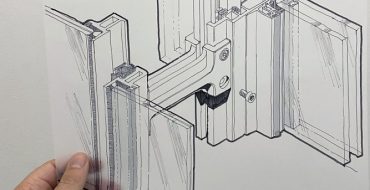
Author: Eduardo Souza
Site: ArchDaily.com
Facades are the first barrier outside a building. They weather rain, snow, winds, sun, and temperature changes. Their primary function is to keep interiors free of water, thermal bridges intact, and internal atmospheres as comfortable as possible. This reality is why the detailing of facades is usually done by experienced architects or specialized companies, who understand materials and construction methods well and are able to select the best solutions for each circumstance. But some projects have facades with such complex detailing, encompassing thousands and thousands of lines, hatches, and dimensions, that they inspire a particularly awestruck response. Making these drawings didactic, technical, and, above all, beautiful, is a task few can achieve to perfection. We spoke with Troy Donovan, the creator of the 188,000 follower Instagram account @the_donnies, who does this job like few others. Read the interview below.
Original Article: https://www.archdaily.com/944811/making-details-beautiful-and-fun-a-conversation-with-at-the-donnies
ArchDaily (AD): Tell me about your studio and its process.
Troy Donovan (TD): I am a Principal at Prism Facades, a Sydney-based façade and engineering practice known for its evolutionary design process. We work closely with architects on public and commercial projects across Australia and New Zealand and specialize in façade design, detailing, low energy, and construction. I enjoy researching how both traditional and new forms of material production can be used in the expression of the building envelope.

Our process is a key part of our approach to design, which offers a greater level of understanding, development, and refinement for the façade scheme. Early in the concept design stage, we typically develop a design with material samples and sketching to explore options and ideas. Later, these sketches become more refined and detailed. We then use 3D modelling and rendering to develop a final set of details, which we will often 3D print or mill from timber and metal to create practical prototypes, usually at 1:1 or 2:3 scale. Once we have completed a design, we will document the processes with traditional CAD, supported with images, photographs, and models from the design process.
For me, sketching is a key part of design research, thinking through the manufacturing steps, and finding new applications for materials and manufacturing processes. My sketching style is best described as loose technical drawing—it can be captured in a notebook or on a napkin, or digitally. My drawing style has developed as a means of interrogating and validating architectural details before committing to CAD or 3D modelling.
AD: Why is sketching important in the design process?

TD: I think it has only been recently that I have come to fully understand the importance of sketching to my design process. Sketching fills in the gaps during the documentation process and provides a level of editing not available with other media. For me drawing a process forces you to think about each component of manufacture or installation as you create—this can sometimes be missed when focusing on the production of a drawing in CAD or a 3D model.
AD: How do you use sketching in your studio?
TD: Façade design bridges architecture and engineering, and sketching is the most important communication tool to illustrate engineering or material constraints and uncovering design opportunities. Sketching during meetings is essential to a collaborative design process—it drastically reduces the amount of email correspondence while enriching our communication with design teams.
I tend to design at multiple scales and jump from the overall form of a building to the window and cladding details and then back again. When I need to focus on a larger scale or concept I use a sharpie marker which forces me to create low-res sketches and resist the temptation to dive into the details. Even at the point where my designs are developed in CAD, the sketching process always runs in parallel and is used to quickly resolve details before I refine them. I was encouraged by some colleagues to embrace digital sketching and there have been so many benefits to this uptake—for instance, the undo no longer requires the use of a safety razor and I can sketch during VCs and share in real-time. The design process has made working remotely more interactive and engaging in recent months, while exporting drawings for Instagram posts, laser cutting, and presentations are far simpler.


While I’ve worked in 3D my entire career, the construction industry still relies heavily on 2D drawings. Sketching performs a valuable role during the shop drawing review process as you can show the intersection between plan and section. This is when isometric sketches are used to illustrate issues with a contractor’s design… and sometimes its holes! A key service we provide to our architectural colleagues is our deep understanding of façade construction and a few revisions on paper can quickly avoid disappointment on site.

AD: What is your favorite piece of sketching equipment?
TD: I usually use an iPad with Concepts app. More recently I’ve been using Morpholio, but I always carry a small Moleskine note book so that I can capture my thoughts and notes on the go. Freehand sketching also means that if I arrive early to a meeting my time isn’t wasted, and nor is my travel time. I have a fascination with screws and fasteners so switching to the iPad means I have an in-built library of reusable components and no longer have to carry an isometric ellipse template to achieve the perfect fixing detail.


“For me, designing is an essential part of design research, thinking about the manufacturing steps, and finding new applications for materials and manufacturing processes. I like to research how traditional and new ways of producing materials can be used to express the construction envelope. ”
Finally, Donovan’s main advice is: “Keep drawing! It’s good for you!” Follow his posts on the Instagram account.